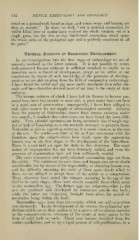Page 532 - My FlipBook
P. 532
542 DENTAL EMBRYOLOGY AND HISTOLOGY.
cuted on a groundwork broad as time and whose scope and bearing are
deep as eternity." In them we find, "not a material connection by
which blind laws of matter have evolved the whole creation out of a
single germ, but the clue to that intellectual conception which spans
the whole series of the geological ages and is perfectly consistent in all
its parts."
General Account of Embryonic Development.
In our investigations into the first stages of embryology we are of
necessity confined to the lower animals. It is not possible to secure
well-preserved human embryos in sufficient numbers to enable us to
formulate even a theory of development, except as we arrive at our
conclusions by reason of such knowledge of the processes of develop-
ment as we are able to glean from the field of comparative embryology.
I have found the rabbit and pig more easily obtainable than other ani-
mals, and have therefore devoted most of my time to the study of their
embryos.
The human embryos of which I have had the fortune to become pos-
sessed have been two months or more old ; a great many have not been
in a good state of preservation ; consequently, I have been obliged to
seek other sources for my supply of microscopical material. Judging
from the paucity of illustrations drawn from human embryos under
tM'o months, I conclude that other observers have found the same diffi-
culty. Very valuable specimens are being constantly lost through neg-
lect or lack of knowledge as to the methods necessary to preserve them.
Noticeable as this is regarding embryos, it is much more so in the case
of the ova. No studies—at least so far as I am conversant with the
literature upon the subject—have been made upon the segmenting
human ova or the first stages in the development of the blastoderm.
There is a vast field yet open for study in this direction. The exact
nature of impregnation has not been definitely settled, and even the
processes of segmentation have not been sufficiently studied.
The most convenient and easily-obtained mammalian eggs are from
the rabbit. The variations between them and human ova are no doubt
considerable, but by reason of the imjwssibility of obtaining human ova,
and the difficulty attending the study of those more closely allied to
them, we are obliged to accept those of the rabbit as a compromise.
Many observers have noted the changes occurring in the egg of the
fowl in its early stages ; these very closely resemble those which occur
in the mammalian egg. The former eggs are oviparous—that is, the
ova are ])roduced and developed by incubation outside the body;
wiiile the latter are rivipni-ou.s, brought forth alive, the period of
incubation being within the body.
Mammalian eggs come from two ovaries, M'hich are said to produce
ova alternately. In the development of the ovaries the cylindrical epi-
thelium which covers their surface is by a process of involution enclosed
in the connective-tissue substance of the ovary at many points in the
form of solid buds or cords. These soon become detached from the
surface epithelium, and set up a rapid process of cell-proliferation, in a


